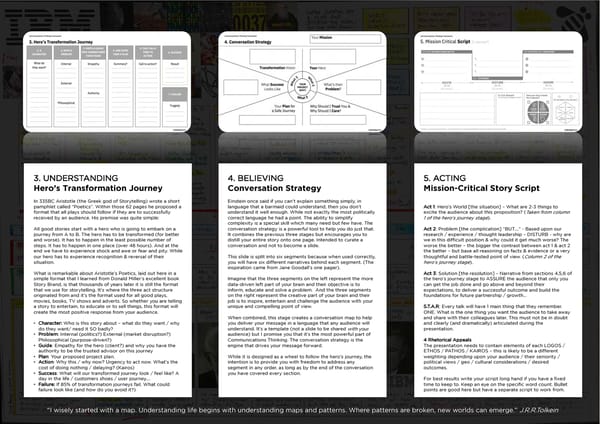3. UNDERSTANDING 4. BELIEVING 5. ACTING Hero’s Transformation Journey Conversation Strategy Mission-Critical Story Script In 335BC Aristotle (the Greek god of Storytelling) wrote a short Einstein once said if you can’t explain something simply, in pamphlet called “Poetics”. Within those 62 pages he proposed a language that a barmaid could understand, then you don’t Act 1: Hero’s World [the situation] – What are 2-3 things to format that all plays should follow if they are to successfully understand it well enough. While not exactly the most politically excite the audience about this proposition? (Taken from column received by an audience. His premise was quite simple: correct language he had a point. The ability to simplify 1 of the hero’s journey stage). complexity is a special skill which many need but few have. The All good stories start with a hero who is going to embark on a conversation strategy is a powerful tool to help you do just that. Act 2: Problem [the complication] “BUT….” - Based upon our journey from A to B. The hero has to be transformed (for better It combines the previous three stages but encourages you to research / experience / thought leadership – DISTURB - why are and worse). It has to happen in the least possible number of distill your entire story onto one page. Intended to curate a we in this difficult position & why could it get much worse? The steps. It has to happen in one place (over 48 hours). And at the conversation and not to become a slide. worse the better – the bigger the contrast between act 1 & act 2 end we have to experience shock and awe or fear and pity. While the better – but base all reasoning on facts & evidence or a very our hero has to experience recognition & reversal of their This slide is split into six segments because when used correctly, thoughtful and battle-tested point of view. (Column 2 of the situation. you will have six different narratives behind each segment. (The hero’s journey stage). inspiration came from Jane Goodall’s one pager). What is remarkable about Aristotle’s Poetics, laid out here in a Act 3: Solution [the resolution] – Narrative from sections 4,5,6 of simple format that I learned from Donald Miller’s excellent book Imagine that the three segments on the left represent the more the hero’s journey stage to ASSURE the audience that only you Story Brand, is that thousands of years later it is still the format data-driven left part of your brain and their objective is to can get the job done and go above and beyond their that we use for storytelling. It’s where the three act structure inform, educate and solve a problem. And the three segments expectations, to deliver a successful outcome and build the originated from and it’s the format used for all good plays, on the right represent the creative part of your brain and their foundations for future partnership / growth… movies, books, TV shows and adverts. So whether you are telling job is to inspire, entertain and challenge the audience with your a story to entertain, to educate or to sell things, this format will unique and compelling point of view. S.T.A.R : Every talk will have 1 main thing that they remember. create the most positive response from your audience. ONE. What is the one thing you want the audience to take away When combined, this stage creates a conversation map to help and share with their colleagues later. This must not be in doubt Character: you deliver your message in a language that any audience will and clearly (and dramatically) articulated during the • Who is this story about – what do they want / why understand. It’s a template (not a slide to be shared presentation. do they want/ need it SO badly? with your Problem • : Internal (politics?) External (market disruption?) audience) but I promise you that it’s the most powerful part of Philosophical (purpose-driven?) Communications Thinking. The conversation strategy is the 4 Rhetorical Appeals • Guide : Empathy for the hero (client?) and why you have the engine that drives your message forward. The presentation needs to contain elements of each LOGOS / authority to be the trusted advisor on this journey ETHOS / PATHOS / KAIROS – this is likely to be a different Plan • : Your proposed project plan. While it is designed as a wheel to follow the hero’s journey, the weighting depending upon your audience / their seniority / • Action: Why this / why now? Urgency to act now. What’s the intention is to provide you with freedom to address any political views / geo / cultural considerations / desired cost of doing nothing / delaying? (Kairos) segment in any order, as long as by the end of the conversation outcomes. • Success : What will our transformed journey look / feel like? A you have covered every section. day in the life / customers shoes / user journey…. For best results write your script long hand if you have a fixed • Failure: If 85% of transformation journeys fail. What could time to keep to. Keep an eye on the specific word count. Bullet failure look like (and how do you avoid it?) points are good here but have a separate script to work from. “I wisely started with a map. Understanding life begins with understanding maps and patterns. Where patterns are broken, new worlds can emerge.” J.R.R.Tolkein
 The Art of the ONE Pager Page 70 Page 72
The Art of the ONE Pager Page 70 Page 72